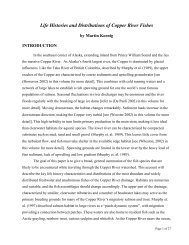Mitigation for the Construction and Operation of Libby Dam
Mitigation for the Construction and Operation of Libby Dam
Mitigation for the Construction and Operation of Libby Dam
Create successful ePaper yourself
Turn your PDF publications into a flip-book with our unique Google optimized e-Paper software.
depth <strong>of</strong> burbot that were relocated during daylight searches using acoustic gear was 35.6<br />
m, which was significantly deeper than <strong>the</strong> mean depth which we operated traps (14.8 m).<br />
We were not able to discern any clear movement patterns <strong>for</strong> <strong>the</strong> tagged fish in terms <strong>of</strong><br />
ei<strong>the</strong>r upstream or downstream movement. Of <strong>the</strong> 40 tagged burbot. However, we were<br />
able to determine that many <strong>of</strong> <strong>the</strong> tagged burbot extensively utilized <strong>the</strong> submerged<br />
Kootenai River channel <strong>and</strong> floodplain during daylight hours.<br />
• We sampled macroinvertebrates at <strong>the</strong> <strong>Libby</strong> Creek Upper Clevel<strong>and</strong> Project <strong>and</strong> <strong>the</strong><br />
Grave Creek Phase I Restoration Projects to assess <strong>the</strong> macroinvertebrate community<br />
response to <strong>the</strong>se two stream restoration projects. We used <strong>the</strong> following metrics <strong>for</strong><br />
comparison be<strong>for</strong>e <strong>and</strong> after restoration activities: taxa richness, EPT [Ephemeroptera,<br />
Plecoptera <strong>and</strong> Tricoptera] index (e.g., contribution <strong>of</strong> EPT-taxa), Simpsons Diversity<br />
(D), <strong>the</strong> ratio <strong>of</strong> Baetidae: Ephemeroptera, <strong>the</strong> contribution <strong>of</strong> Diptera, <strong>the</strong> proportional<br />
abundance <strong>of</strong> burrowers <strong>and</strong> sprawlers (sediment tolerant), <strong>and</strong> <strong>the</strong> contribution <strong>of</strong><br />
collector-ga<strong>the</strong>rers. At <strong>the</strong> <strong>Libby</strong> Creek Upper Clevel<strong>and</strong> Project site, 3 <strong>of</strong> <strong>the</strong> 7 metrics<br />
had values in 2003 that were significantly different from <strong>the</strong> values attained from <strong>the</strong> prerestoration<br />
values. However, <strong>the</strong>y were all in <strong>the</strong> opposite direction expected. We<br />
specifically expected <strong>the</strong> relative abundance <strong>of</strong> sensitive organisms (% EPT) to increase<br />
<strong>and</strong> <strong>the</strong> dominance <strong>of</strong> tolerant organisms (% Diptera <strong>and</strong> % Collector-ga<strong>the</strong>rers) to<br />
decrease as conditions become more natural. We observed <strong>the</strong> opposite <strong>and</strong> this usually<br />
indicates an ecosystem is that has been recently disturbed. None <strong>of</strong> <strong>the</strong> Grave Creek<br />
metrics tested showed a statistically significant difference between <strong>the</strong> pre- <strong>and</strong> postrestoration<br />
samples. Results show that sampling should continue <strong>for</strong> a longer period as<br />
<strong>the</strong> streams recover.<br />
• We conducted juvenile salmonid population estimates within reference reaches on<br />
Sinclair, Therriault, Grave, Young, <strong>Libby</strong>, Parmenter, <strong>and</strong> Pipe creeks. Trend analyses<br />
relevant to stream restoration projects are presented <strong>for</strong> Grave <strong>and</strong> <strong>Libby</strong> creeks.<br />
• Montana FWP has documented <strong>the</strong> changes in species composition, <strong>and</strong> species size <strong>and</strong><br />
abundance within <strong>Libby</strong> Reservoir since <strong>the</strong> construction <strong>of</strong> <strong>Libby</strong> <strong>Dam</strong>. We continued<br />
monitoring fish populations within <strong>the</strong> reservoir using spring <strong>and</strong> fall gill netting <strong>and</strong><br />
present <strong>the</strong> results <strong>and</strong> trend analyses <strong>for</strong> 11 fish species. The spring gill net catch <strong>of</strong> bull<br />
trout has significantly increased since 1990. We were able to improve <strong>the</strong> linear regression<br />
model <strong>for</strong> bull trout gillnet catch between years by adjusting <strong>the</strong> mean bull trout catch per<br />
net by reservoir volume at <strong>the</strong> time <strong>the</strong> nets were fished each year. Bull trout redd counts in<br />
both <strong>the</strong> Wigwam River <strong>and</strong> Grave Creek are both significantly <strong>and</strong> positively correlated to<br />
<strong>the</strong> spring gill net catch rates <strong>for</strong> bull trout adjusted <strong>for</strong> reservoir elevation.<br />
• Montana FWP has monitored zooplankton species composition, abundance <strong>and</strong> size <strong>of</strong><br />
zooplankton within <strong>the</strong> reservoir since <strong>the</strong> construction <strong>and</strong> filling <strong>of</strong> <strong>Libby</strong> <strong>Dam</strong>.<br />
Zooplankton abundance, species composition, <strong>and</strong> size distribution have also all been<br />
similar during <strong>the</strong> second half <strong>of</strong> <strong>the</strong> reservoir’s history. Cyclops <strong>and</strong> Daphnia have been<br />
<strong>the</strong> first <strong>and</strong> second most abundant genera <strong>of</strong> zooplankton present in <strong>the</strong> reservoir since<br />
1997.<br />
3
















